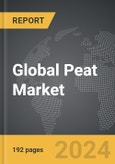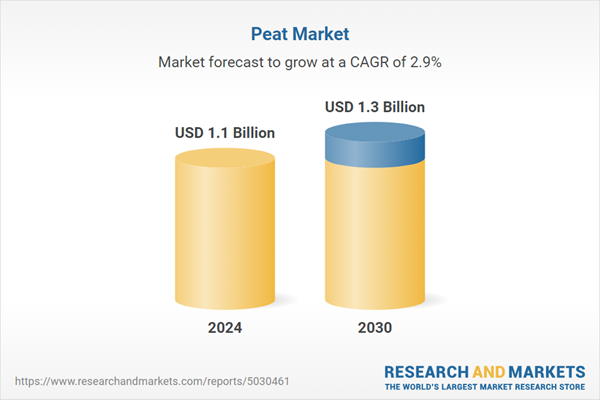The global market for Peat was valued at US$1.1 Billion in 2024 and is projected to reach US$1.3 Billion by 2030, growing at a CAGR of 2.9% from 2024 to 2030. This comprehensive report provides an in-depth analysis of market trends, drivers, and forecasts, helping you make informed business decisions. The report includes the most recent global tariff developments and how they impact the Peat market.
Segments: Material (Hemic, Sapric, Other Materials); Application (Fuel & Energy, Agriculture & Horticulture, Domestic Use, Medicine, Other Applications).
Geographic Regions/Countries: World; United States; Canada; Japan; China; Europe (France; Germany; Italy; United Kingdom; Spain; Russia; and Rest of Europe); Asia-Pacific (Australia; India; South Korea; and Rest of Asia-Pacific); Latin America (Argentina; Brazil; Mexico; and Rest of Latin America); Middle East (Iran; Israel; Saudi Arabia; United Arab Emirates; and Rest of Middle East); and Africa.
The analysts continuously track trade developments worldwide, drawing insights from leading global economists and over 200 industry and policy institutions, including think tanks, trade organizations, and national economic advisory bodies. This intelligence is integrated into forecasting models to provide timely, data-driven analysis of emerging risks and opportunities.
Global Peat Market - Key Trends & Drivers Summarized
How Are Technological Advancements Shaping the Peat Industry?
The peat industry has been experiencing significant advancements in both extraction methods and applications, driven by technology and the demand for sustainable agricultural practices. Peat, a natural accumulation of decayed organic material, is primarily used in horticulture as a soil conditioner and growing medium. Technological innovations in peat harvesting have focused on minimizing environmental impacts, ensuring the sustainability of peat bogs, and improving the efficiency of extraction. Modern machinery and automated systems now allow for more precise harvesting, reducing waste and soil disturbance, while innovations in water management technology are helping preserve surrounding ecosystems during extraction. Additionally, advancements in composting technology have made it possible to create peat alternatives or blends that replicate the beneficial properties of peat, thereby catering to industries like horticulture that are looking to reduce their environmental footprint. As the agricultural and energy sectors look to reduce their carbon emissions, research into more sustainable uses and alternatives to peat continues to drive innovation.Why Is Peat a Key Component in Horticulture and Energy Production?
Peat plays a critical role in various sectors, particularly horticulture and energy production. In horticulture, peat is prized for its water-retention properties and its ability to aerate soil, making it an essential growing medium for seedlings, potting mixes, and greenhouse crops. It helps plants develop strong root systems and supports balanced moisture retention, which is particularly important in intensive agricultural practices and organic farming. Beyond horticulture, peat has historically been used as a fuel source in certain regions, particularly in northern Europe, where it is harvested, dried, and burned for heat and energy production. Although its use as a fuel source has diminished with the rise of renewable energy alternatives, it still holds cultural and economic importance in some countries. The versatility of peat in these industries has cemented its position as a valuable natural resource, even as environmental concerns around peatland depletion and carbon emissions are prompting discussions about more sustainable management and alternatives.How Are Environmental Concerns and Regulations Influencing the Peat Market?
Environmental concerns and stringent regulations are having a profound impact on the peat industry, as more attention is being placed on the preservation of peatlands and the mitigation of carbon emissions associated with peat harvesting. Peatlands are known to act as carbon sinks, storing large amounts of carbon dioxide that can be released during extraction, contributing to climate change. As a result, governments and environmental organizations are pushing for stricter regulations and sustainable management practices to protect these vital ecosystems. The European Union, in particular, has implemented regulations that encourage the restoration of peatlands and limit the large-scale extraction of peat. These regulations are forcing companies in the industry to adopt more sustainable harvesting techniques and explore alternatives such as coir, wood fiber, and compost-based growing media. Additionally, consumer demand for environmentally friendly products is prompting horticultural companies to reduce their reliance on peat and seek out greener options. As sustainability becomes a central issue, the peat industry is evolving to meet both regulatory requirements and the growing demand for eco-conscious products.What Factors Are Driving Growth in the Peat Market?
The growth in the peat market is driven by several factors related to technological advancements, increased agricultural demand, and the ongoing need for sustainable energy alternatives. In horticulture, the growing global demand for high-yield crops, along with the increasing use of greenhouse farming, is propelling the adoption of peat-based products that enhance soil quality and water retention. Technological innovations in peat harvesting and processing are also contributing to market growth by improving efficiency and reducing environmental impacts. Additionally, while the use of peat as a fuel source has declined due to the rise of renewable energy, certain regions where peat is an important cultural and economic resource continue to rely on it for energy production, maintaining a niche demand in the market. Environmental concerns and regulatory pressures, while pushing companies to adopt more sustainable practices, are also driving the exploration of peat alternatives, broadening the range of products in the market. As agriculture continues to expand, especially in regions with challenging soil conditions, the demand for peat and its alternatives is expected to rise, sustained by technological advancements and growing awareness of sustainable land-use practices.Report Scope
The report analyzes the Peat market, presented in terms of units. The analysis covers the key segments and geographic regions outlined below.Segments: Material (Hemic, Sapric, Other Materials); Application (Fuel & Energy, Agriculture & Horticulture, Domestic Use, Medicine, Other Applications).
Geographic Regions/Countries: World; United States; Canada; Japan; China; Europe (France; Germany; Italy; United Kingdom; Spain; Russia; and Rest of Europe); Asia-Pacific (Australia; India; South Korea; and Rest of Asia-Pacific); Latin America (Argentina; Brazil; Mexico; and Rest of Latin America); Middle East (Iran; Israel; Saudi Arabia; United Arab Emirates; and Rest of Middle East); and Africa.
Key Insights:
- Market Growth: Understand the significant growth trajectory of the Hemic segment, which is expected to reach US$669.9 Million by 2030 with a CAGR of a 3.6%. The Sapric segment is also set to grow at 2.2% CAGR over the analysis period.
- Regional Analysis: Gain insights into the U.S. market, valued at $295.5 Million in 2024, and China, forecasted to grow at an impressive 4.7% CAGR to reach $256.4 Million by 2030. Discover growth trends in other key regions, including Japan, Canada, Germany, and the Asia-Pacific.
Why You Should Buy This Report:
- Detailed Market Analysis: Access a thorough analysis of the Global Peat Market, covering all major geographic regions and market segments.
- Competitive Insights: Get an overview of the competitive landscape, including the market presence of major players across different geographies.
- Future Trends and Drivers: Understand the key trends and drivers shaping the future of the Global Peat Market.
- Actionable Insights: Benefit from actionable insights that can help you identify new revenue opportunities and make strategic business decisions.
Key Questions Answered:
- How is the Global Peat Market expected to evolve by 2030?
- What are the main drivers and restraints affecting the market?
- Which market segments will grow the most over the forecast period?
- How will market shares for different regions and segments change by 2030?
- Who are the leading players in the market, and what are their prospects?
Report Features:
- Comprehensive Market Data: Independent analysis of annual sales and market forecasts in US$ Million from 2024 to 2030.
- In-Depth Regional Analysis: Detailed insights into key markets, including the U.S., China, Japan, Canada, Europe, Asia-Pacific, Latin America, Middle East, and Africa.
- Company Profiles: Coverage of players such as Bord na Mona, CoCo Green (Pvt.), Elva E.P.T., Global Coirs & Eggs, Jiffy International AS and more.
- Complimentary Updates: Receive free report updates for one year to keep you informed of the latest market developments.
Some of the 37 companies featured in this Peat market report include:
- Bord na Mona
- CoCo Green (Pvt.)
- Elva E.P.T.
- Global Coirs & Eggs
- Jiffy International AS
- Klasmann-Deilmann GmbH
- Lambert
- Oulun Energia Oy
- T&J Enterprises
- Vapo Oy
Tariff Impact Analysis: Key Insights for 2025
Global tariff negotiations across 180+ countries are reshaping supply chains, costs, and competitiveness. This report reflects the latest developments as of April 2025 and incorporates forward-looking insights into the market outlook.The analysts continuously track trade developments worldwide, drawing insights from leading global economists and over 200 industry and policy institutions, including think tanks, trade organizations, and national economic advisory bodies. This intelligence is integrated into forecasting models to provide timely, data-driven analysis of emerging risks and opportunities.
What’s Included in This Edition:
- Tariff-adjusted market forecasts by region and segment
- Analysis of cost and supply chain implications by sourcing and trade exposure
- Strategic insights into geographic shifts
Buyers receive a free July 2025 update with:
- Finalized tariff impacts and new trade agreement effects
- Updated projections reflecting global sourcing and cost shifts
- Expanded country-specific coverage across the industry
Table of Contents
I. METHODOLOGYII. EXECUTIVE SUMMARY2. FOCUS ON SELECT PLAYERSIII. MARKET ANALYSISSOUTH KOREAREST OF ASIA-PACIFICARGENTINABRAZILMEXICOREST OF LATIN AMERICAIRANISRAELSAUDI ARABIAUNITED ARAB EMIRATESREST OF MIDDLE EASTIV. COMPETITION
1. MARKET OVERVIEW
3. MARKET TRENDS & DRIVERS
4. GLOBAL MARKET PERSPECTIVE
UNITED STATES
CANADA
JAPAN
CHINA
EUROPE
FRANCE
GERMANY
ITALY
UNITED KINGDOM
SPAIN
RUSSIA
REST OF EUROPE
ASIA-PACIFIC
AUSTRALIA
INDIA
LATIN AMERICA
MIDDLE EAST
AFRICA
Companies Mentioned (Partial List)
A selection of companies mentioned in this report includes, but is not limited to:
- Bord na Mona
- CoCo Green (Pvt.)
- Elva E.P.T.
- Global Coirs & Eggs
- Jiffy International AS
- Klasmann-Deilmann GmbH
- Lambert
- Oulun Energia Oy
- T&J Enterprises
- Vapo Oy
Table Information
| Report Attribute | Details |
|---|---|
| No. of Pages | 192 |
| Published | April 2025 |
| Forecast Period | 2024 - 2030 |
| Estimated Market Value ( USD | $ 1.1 Billion |
| Forecasted Market Value ( USD | $ 1.3 Billion |
| Compound Annual Growth Rate | 2.9% |
| Regions Covered | Global |









